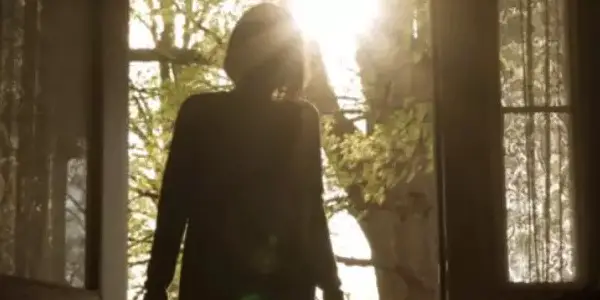H.P. Lovecraft’s Witch House is a film with high ambitions and a low budget. Lovecraft‘s complex plots and impossibly dense descriptions make him a challenging author to adapt into film, even for large-scale production. Thus, while the film delivers several enjoyable, effectively tense set pieces following its protagonist’s attempts to escape the supernatural beings that torment her dreams, the story itself is ultimately underserved by the project’s scope and 85-minute runtime.
Escape to the Witch House
The film follows Alice Gilman (Portia Chellelynn), a graduate student at Miskatonic University in Lovecraft‘s fictional town of Arkham. After her abusive ex-boyfriend has beaten her so badly that she miscarries and is forced to flee their shared home, she finds herself sleeping on her friend’s couch, fearful he’ll find her again. To solve this problem, her thesis advisor (John Johnson) suggests she move into one of the available rooms at the Hannah House, an old mansion whose haunted reputation precedes it. She eagerly obliges.
Upon arrival at the house, she meets her new roommates: a hostile and taciturn matron (Shonda Laverty), her tortured, devout-yet-whiskey-soaked brother, Joe (Joe Padgette), and their friendly, seemingly normal niece, Tommi (Julie Anne Prescott)–– all of whom seem oddly invested in how her time living in the abandoned, rat-infested attic is treating her.

Alice is a student of “sacred geometry and architecture,” focusing her studies on her idea that the way structures are built can create rifts in space-time that serve as portals to the fourth dimension. She’s in luck: After she discovers a leather altar cloth under the floorboards with a pentagram drawn at its center, Alice begins to believe that her new home in the attic of the old house is one such place. Her sudden penchant for sleepwalking and troubling nosebleeds pale in comparison to the rare research opportunity.
Once she begins investigating the history of the house, she learns her new home once belonged to a servant girl named Keziah Mason (Andrea Collins) who was burned at the stake for witchcraft in the 1690s after the bones of several missing children were found in the walls of the attic.
When children in the town begin to go missing, Alice quickly finds herself fainting during class presentations, locked in a tangled web of dreams and reality, witches’ rituals, and the fourth dimension. No friend or lover she turns to is to be entirely trusted – particularly when she is hard pressed to tell whether she’s awake or where she thinks she is at any given moment.
When she finds that, impossibly given her injuries at the hands of her violent ex, she has become pregnant during one of her dreams of a Satanic ritual, she is forced to confront the coven that has taken control of her body – or die trying.
Visions of the Fourth Dimension
Lovecraft‘s stories of monsters from beyond our world are defined in large part by his fascination with literally indescribable phenomena. The story upon which Bobby Easley‘s film is based, “The Dreams in the Witch House,” is no different. Lovecraft’s descriptions of the fourth dimension can be maddeningly vague, for example: “All the objects… were totally beyond description or even comprehension,” in the “Unspeakably menacing and horrible… Twilight abysses… of the fourth dimension.”
With this in mind, the film’s choice to cast Alice’s nightmares in step-framed, Giallo-esque, neon-soaked shadows is an enjoyable contrast to the austere victorian trappings of the haunted house setting (shot in the historic Hannah Mansion in Indiana).
The makeup and practical effects are the film’s highlight, presenting Alice’s demons as either charred, slimy, oozing apparitions or zombielike albino gremlins. Admirably, the film also takes Lovecraftian descriptions like, “iridescent, prolately spheroidal bubbles,” in stride, using CGI to provide the viewer with just that. The quality of these effects, though lower than the practicals, is endearing.
The script endeavors to layer Lovecraft‘s story with narrative references to American folklore like “Young Goodman Brown” and horror films like Rosemary’s Baby in under 90 minutes, leading to time-saving expository exclamations like, “I don’t know what’s happening to me–– I feel like there’s some spiritual force using me!” and “Keziah’s been using you as a vessel for the birth of the antichrist!” That being said, likely in part because of its rushed pacing, the plot is still relentlessly engaging, veritably dragging Alice to its supernatural conclusion.
Conclusion
While H.P. Lovecraft’s Witch House‘s ambitions exceed its scope, often to the detriment of a fully fleshed-out narrative and satisfying character development, it delivers several effective, psychedelic scenes of suspense and an enjoyable atmosphere of supernatural anxiety.
What do you think? What’s your favorite Lovecraft film? Let us know in the comments!
H.P. Lovecraft’s Witch House came out on DVD and streaming on July 5th!
Watch H.P. Lovecraft’s Witch House
Does content like this matter to you?
Become a Member and support film journalism. Unlock access to all of Film Inquiry`s great articles. Join a community of like-minded readers who are passionate about cinema - get access to our private members Network, give back to independent filmmakers, and more.